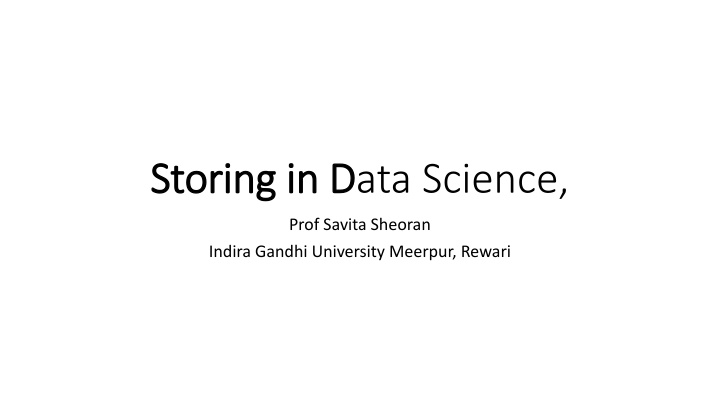
Key Aspects of Data Storage in Data Science
"Learn about the key aspects of storing data in data science, including types of data storage, data formats, best practices, and storage for big data and machine learning. Explore relational databases, NoSQL databases, data warehouses, data lakes, cloud storage, and file systems for efficient and secure data storage in data science."
Download Presentation

Please find below an Image/Link to download the presentation.
The content on the website is provided AS IS for your information and personal use only. It may not be sold, licensed, or shared on other websites without obtaining consent from the author. If you encounter any issues during the download, it is possible that the publisher has removed the file from their server.
You are allowed to download the files provided on this website for personal or commercial use, subject to the condition that they are used lawfully. All files are the property of their respective owners.
The content on the website is provided AS IS for your information and personal use only. It may not be sold, licensed, or shared on other websites without obtaining consent from the author.
E N D
Presentation Transcript
Storing in D Storing in Data Science, Prof Savita Sheoran Indira Gandhi University Meerpur, Rewari
Introduction In data science, storing data refers to the process of saving, managing, and organizing data for analysis, modeling, and later retrieval. Data storage is a crucial aspect of the data pipeline as it ensures that data can be accessed efficiently, securely, and in a structured format that supports the business objectives.
Key Aspects of Storing Data in Data Science Key Aspects of Storing Data in Data Science 1. Types of Data Storage 2. Data Formats for Storage 3. Data Storage in the Context of Data Science 4. Best Practices for Storing Data in Data Science 5. Storing Data for Big Data and Machine Learning
Types of Data Storage Data can be stored in several formats and systems, depending on the use case, the data s size, and the required retrieval speed. The common types of storage systems used in data science include: a) Relational Databases (SQL): Relational databases store data in tables and use Structured Query Language (SQL) to query and manipulate the data. These databases are useful for highly structured data and require complex queries. Examples: MySQL, PostgreSQL, Microsoft SQL Server Use Case: Storing structured data (e.g., customer records, transaction data) that can be represented in tabular form. b) NoSQL Databases: NoSQL databases are designed to store unstructured or semi- structured data that doesn't fit well into traditional relational databases. They allow more flexibility in data format and schema, making them ideal for large-scale or varied data sources. Examples: MongoDB, Cassandra, CouchDB Use Case: Storing large amounts of data that may not conform to a fixed schema (e.g., social media posts, logs, sensor data)
Types of Data Storage c) Data Warehouses: A data warehouse is a centralized repository designed to store structured data from multiple sources for reporting and analysis. It's often used for business intelligence and analytics. Examples: Amazon Redshift, Google BigQuery, Snowflake Use Case: Storing large volumes of historical business data that is used for running complex queries and analytics. d) Data Lakes: A data lake is a storage system that can hold large amounts of raw, unstructured, or structured data. Unlike a data warehouse, which stores processed and structured data, a data lake can store data in its raw form, allowing for more flexibility in data exploration and processing. Examples: Amazon S3, Hadoop Distributed File System (HDFS), Azure Data Lake Use Case: Storing large volumes of diverse data types (e.g., images, text, log files, video, sensor data) for analysis, machine learning, and big data processing e) Cloud Storage: Cloud storage refers to storing data on remote servers managed by cloud service providers. These services allow businesses to scale their data storage needs without worrying about hardware management. Examples: Google Cloud Storage, AWS S3, Microsoft Azure Storage Use Case: Storing large datasets that are accessed remotely, allowing for easy scalability and high availability. f) File Systems: Storing data as files in local or distributed file systems is a simple yet common approach, especially for unstructured data. File systems can support both structured and unstructured data, typically in formats like CSV, JSON, Parquet, and others. a) Examples: HDFS, local file systems, Amazon S3 b) Use Case: Storing large datasets or logs, which can be processed by tools like Apache Spark, Python, or R.
Data Formats for Storage The way data is stored can affect its efficiency, speed of access, and ease of processing. Different formats are used depending on the use case, such as: a. CSV (Comma-Separated Values) Use Case: Simple storage of tabular data; easy to read and write, but not efficient for large- scale data processing. b. JSON (JavaScript Object Notation) Use Case: Storing semi-structured data that can represent nested objects and arrays (e.g., configuration files, web data). c. Parquet and ORC (Optimized Row Columnar) Use Case: Columnar storage formats used in data lakes and data warehouses. These formats are efficient for reading specific columns of large datasets, which is common in analytics tasks. d. Avro Use Case: A binary format commonly used in data pipelines and for storing schema-based data (e.g., Kafka logs)
Data Storage in the Context of Data Science In the data science process, storing data is not just about saving it for later, but about creating an effective system for managing large datasets, cleaning data, and preparing it for analysis and modeling. The storage needs depend on various factors such as: Volume: The amount of data being stored (e.g., gigabytes, terabytes, petabytes). Variety: The types of data (e.g., structured, unstructured, semi-structured). Velocity: How quickly new data is generated and needs to be ingested into the system. Data storage systems in data science support tasks such as: Data Cleaning: Storing clean datasets that can be used for analysis and training machine learning models. Data Exploration: Storing raw or semi-processed data to allow for easy exploration and discovery of patterns or insights. Feature Engineering: Storing intermediate or transformed data that can be used for building features in machine learning models. Model Training: Storing datasets used for training machine learning models, along with the model s parameters and weights
Best Practices for Storing Data in Data Science To ensure that data is effectively stored and managed for data science purposes, several best practices should be followed: Data Organization: Data should be stored in an organized manner, making it easy to retrieve and use. This could involve creating directories, naming conventions, and tagging data. Example: For a company that processes customer data, organize the data by date, region, and product line. Data Versioning: Keeping track of changes to datasets over time is crucial for reproducibility and debugging. This can be done using version control systems like DVC (Data Version Control) or cloud-based version control systems. Example: For machine learning models, keep track of the data and the model versions to ensure that the results can be replicated
Best Practices for Storing Data in Data Science Data Security: Protecting sensitive data is a priority. Use encryption and access control mechanisms to ensure that data is safe from unauthorized access. Example: Storing customer data in encrypted form to comply with privacy regulations like GDPR Scalability: Data storage systems should be able to scale efficiently as data grows over time. This is particularly important in big data environments where the volume of data is rapidly increasing. Example: Cloud storage systems like Amazon S3 can scale up as data storage needs grow Data Backup: Regular backups of data are necessary to prevent data loss due to hardware failure, accidental deletion, or other issues. Example: Backing up all data from a database to cloud storage to ensure it is recoverable if needed.
Storing Data for Big Data and Machine Learning In big data scenarios, data is often stored in distributed systems that allow for horizontal scaling, meaning the storage system can handle increasing data volumes by adding more machines to the system. Distributed Storage Systems like Hadoop HDFS and Google Cloud Storage enable the storage of large datasets across many machines. Data is split into smaller chunks and distributed across different nodes for parallel processing Example: Storing data from IoT sensors (e.g., temperature, humidity, pressure) in a distributed file system that allows for high-speed processing using distributed frameworks like Apache Spark. Machine Learning Data Storage For machine learning projects, storing data efficiently can help speed up the process of training models. Datasets are often split into training, validation, and testing sets, with each set stored separately. Example: Storing training data in a database and storing model weights and hyperparameters in version-controlled files for later use
Example Scenario: Customer Behavior Analysis in E-commerce Let s imagine an e-commerce company wants to analyze customer behavior to improve sales and increase customer retention. The company collects various types of data, including customer demographics, transaction history, customer service interactions, and product preferences. To perform this analysis, the company needs to store the data efficiently. Types of Data and Storage Requirements In this scenario, we will deal with a variety of data types: Structured Data: Data that fits neatly into tables, like customer details, order histories, etc. Unstructured Data: Data such as customer reviews, product descriptions, and images. Semi-structured Data: Data that has some structure but not in a strict tabular format, like logs, JSON data from APIs, etc. The company needs to choose an appropriate storage system based on these requirements
Storing Structured Data (SQL Database) The company decides to store structured data in a relational database like PostgreSQL because it is well-suited for tabular data with a defined schema. The structured data might include: Customer Information (e.g., Name, Email, Address) Order Details (e.g., Order ID, Product ID, Quantity, Order Date) Customer Table: Custm_ID Name Email Address1 1 John Doe john.doe@email.com 123 Elm St, NY 2 Jahn Doe jahn.doe@email.com 456 Oak St, NY This structured data is easy to store, query, and analyze using SQL. For instance, to find out the total quantity of products purchased by a customer, you can query the database: SELECT Customer_ID, SUM(Quantity) AS Total_PurchasedFROM Orders GROUP BY Customer_ID;
Storing Unstructured Data (File System or NoSQL Database) Unstructured data such as customer reviews, product images, and customer service chat logs doesn t fit well into the relational database. The company can store unstructured data using: File systems for storing large files like product images (e.g., AWS S3, Google Cloud Storage). NoSQL databases like MongoDB for semi-structured text data, such as customer reviews and chat logs. Example: Storing Customer Reviews in MongoDB The company could store customer reviews in a MongoDB database in a JSON-like format, which allows for flexible and scalable storage. Customer Reviews Collection (JSON format): { "review_id": "r101", "customer_id": 1, "product_id": 205, "rating": 4.5, "review_text": "Great product! I love it.", "review_date": "2025-02-16" } Each review is stored as a document in MongoDB. This allows the company to easily store reviews with varied fields, such as text, rating, and review date, without enforcing a strict schema like in relational databases.
Storing Semi-structured Data (Data Lake or NoSQL) Semi-structured data like JSON or XML files, or even API responses from the e-commerce platform, can be stored in data lakes or NoSQL databases. For example, data about product interactions (e.g., user clicks, browsing history) might be stored in a data lake like Amazon S3 in Parquet format, which is optimized for analytical queries. The semi-structured data might look like this: { "user_id": 1, "session_id": "abcd1234", "actions": [ {"timestamp": "2025- 02-15T12:00:00", "action": "view", "product_id": 205}, {"timestamp": "2025-02-15T12:05:00", "action": "add_to_cart", "product_id": 209}, {"timestamp": "2025-02-15T12:10:00", "action": "purchase", "product_id": 205} ] } This JSON file can be stored in a data lake and later analyzed for patterns (e.g., how often users add items to the cart before making a purchase).
Storing Large Datasets for Big Data Processing (Distributed File System) As the company scales and accumulates more data (e.g., millions of customer interactions, transactions, reviews), it will need to use distributed storage systems to handle the volume, velocity, and variety of data. For instance, the company could use Hadoop Distributed File System (HDFS) to store big data in a distributed way across many machines. Apache Spark or Hadoop MapReduce can then be used for large-scale data processing tasks such as customer segmentation, recommendation engine training, or churn prediction. Example: Storing Customer Interaction Logs in HDFS hdfs dfs -put customer_interactions.csv /user/data/customer_logs/ This stores a large dataset in a distributed file system, allowing for parallel processing later using distributed computing frameworks like Spark.
Cloud Storage Solutions Given the large volume of data and the need for scalability, the company might choose to use cloud storage systems, such as Amazon S3 or Google Cloud Storage, for storing both structured and unstructured data. Structured Data (Customer details, orders) can be stored in Cloud Databases like Amazon RDS or Google Cloud SQL. Unstructured Data (Images, logs, customer reviews) can be stored in Cloud Object Storage like Amazon S3 or Google Cloud Storage. The cloud provides flexibility, scalability, and high availability, making it ideal for data storage in data science projects
Best Practices for Storing Data in Data Science Data Versioning: Use tools like DVC (Data Version Control) to keep track of changes in datasets over time, which is especially useful for machine learning projects. Data Security: Ensure sensitive data is encrypted both at rest (on storage systems) and in transit (during transfer). Use access control measures to protect data. Backup and Recovery: Implement regular backups to avoid data loss and ensure recovery options are in place in case of system failure. Scalability: As the company grows, the storage system should scale seamlessly to accommodate increasing data volumes, such as by using distributed databases or cloud storage






















